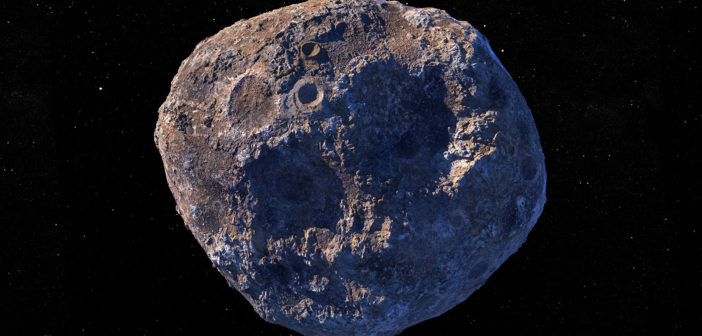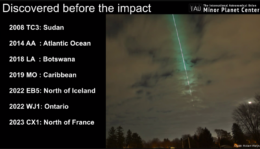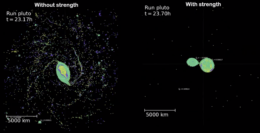Editor’s Note: This week we’ll be writing updates on selected events at the 55th Division for Planetary Sciences (DPS) meeting, held jointly with the Europlanet Science Congress (EPSC) in San Antonio, Texas, and online. The usual posting schedule for AAS Nova will resume on October 9th.
Table of Contents:
- Farinella Prize Lecture (Federica Spoto and Diego Turrini)
- BepiColombo en Route to Mercury: Mission Overview and First Results: (Johannes Benkhoff and Anna Mililo)
- Press Conference (Anicia Arredondo, Sonia Fornasier, and Adeene Denton)
Farinella Prize Lecture (Federica Spoto and Diego Turrini) (by Ben Cassese)
The week of science kicked off with a plenary session that was split between award winners and explorers of our innermost planet, Mercury.
First up was Federica Spoto of the Minor Planet Center in Cambridge, Massachusetts. She was one of the two recipients of the 2023 Farinella Prize, an award given to younger planetary scientists active in areas of research that captivated Italian scientist Paolo Farinella before his tragic premature death in 2000. Her presentation detailed recent advances in the last decade in the Minor Planet Center’s ability to disseminate alerts about asteroids about to strike Earth.
To date, we have caught seven small asteroids before each of them collided without significant damage, and when looking back on their detections, one might be forgiven for assuming they tried to evade the asteroid police of Cambridge. One of the first, 2014AA, was only observed by one astronomer who spotted it on New Year’s Eve: without an automated system in place to distribute alerts and with the staff of the Minor Planet Center either asleep or busy ringing in 2014, no one else knew of it until after impact. In the decade since, however, systems have been upgraded and now operate nearly completely automatically. They now work so efficiently that Spoto only had to casually supervise them when the first observations of the most recent pre-discovered impactor streamed in during Rihanna’s Super Bowl Halftime Show. She successfully coordinated follow-up observations while watching the pop icon’s performance.Up next was the other winner of this year’s Farinella Prize, Diego Turrini of the National Institute for Astrophysics – Turin Astrophysical Observatory. Turrini presented on the recent advances in our understanding of small impactors and the cumulative effects of their tiny craters. Excitingly, this included insights not only from within our own solar system, but also from observations of other, distant solar systems as they form. With the help of the ALMA observatory’s unprecedented sensitivity to dust emission around faraway stars, we are beginning to empirically measure the properties of colliding protoplanets in laboratories beyond our own backyard.
BepiColombo en Route to Mercury: Mission Overview and First Results: (Johannes Benkhoff and Anna Mililo) (by Ben Cassese)
The session concluded with a two-part talk delivered by Johannes Benkhoff and Anna Mililo on the BepiColombo mission to Mercury. Benkhoff was the lead off hitter, and he took his time on the plenary stage to give an overview of the joint European–Japanese mission to the innermost planet. This included a description of the complex, three-part spacecraft, and assembly that consists of a solar-electric powered cruise stage and two separate orbiters that will eventually circle Mercury upon their arrival in December 2025. The whole craft has been operating as expected since its launch in 2018, and it has completed six of the nine required flybys needed to maneuver inwards through the solar system before its final orbital insertion.
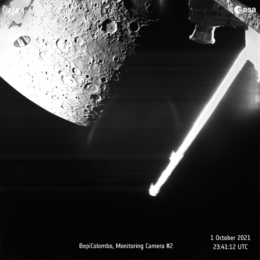
BepiColombo’s view of Mercury during its first flyby prior to eventual orbit insertion. [ESA/BepiColombo/MTM]
Press Conference (Recording available here) (by Kerry Hensley)
Anicia Arredondo (Southwest Research Institute) kicked off the first press conference of DPS–EPSC with a discussion of new findings about asteroid (16) Psyche. Psyche is a 170-mile-diameter asteroid in the asteroid belt between Mars and Jupiter, and our observations indicate that Psyche is 30–60% iron by volume. This suggests that the asteroid was once the core of a small planet like Earth or Mars that experienced a massive collision during its formation, losing its rocky mantle and leaving only the metal core behind. A NASA mission to the asteroid, also named Psyche, is slated to launch on 12 October 2023, reaching the asteroid in 2029 and embarking on 26 months in orbit around this metallic world. The mission will allow us to study how planets form in an entirely new way, and in preparation for its arrival, researchers are using all available means to study Psyche.
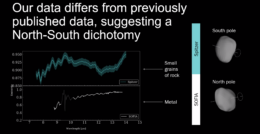
Spectra of Psyche showing the difference in features seen with the Spitzer Space Telescope (top) and SOFIA (bottom). Click to enlarge. [Slide by Anicia Arredondo]
Sonia Fornasier (LESIA-Université Paris Cité) discussed photometry of Phobos, the larger of Mars’s two small moons. The origins of Mars’s moons (the other moon is named Deimos) has long been debated, with two leading theories: 1) the moons are captured asteroids, which explains their reddish colors that match that of other asteroids, or 2) the moons formed where they are, in orbit around Mars, in the aftermath of a giant collision, which explains their nearly circular orbits. Neither theory fits all the available data — it’s not clear how captured asteroids would fall into such circular orbits, and Phobos and Deimos are spectrally dissimilar from Mars. Luckily, the Japanese Space Agency’s Martian Moons eXploration (MMX) mission will help solve this riddle, returning samples from two distinct regions on Phobos’s surface.

Phobos’s reflectance properties place it in the realm of asteroids rich in carbonaceous material. Click to enlarge. [Slide by Sonia Fornasier]
Adeene Denton (University of Arizona) wrapped up the session with a look at Pluto and its moon, Charon. The Pluto–Charon system is interesting because of how large Charon is relative to Pluto; Charon is larger compared to Pluto than the Moon is to Earth, and the center of mass of the system lies outside Pluto. One possibility for how the system came to be as it is today is through a giant collision, which is also how the Earth–Moon system is thought to have formed. Things are a little different 40 au from the Sun, though, as objects tend to be less massive and move more slowly. This means that the effects of material strength — the ability of a material to resist deformation — are important in determining the outcome of a collision.
Using computer simulations, Denton showed that a collision between Pluto and Charon that neglects material strength exaggerates the amount of deformation and results in a single body rather than two bodies. Including material strength results in a very different collision: the two bodies collide, stick together, spin around, then decouple and remain in a close orbit. This process also heats Charon’s interior long term, which may have implications for the formation and survival of oceans on Charon and other icy Kuiper Belt objects.